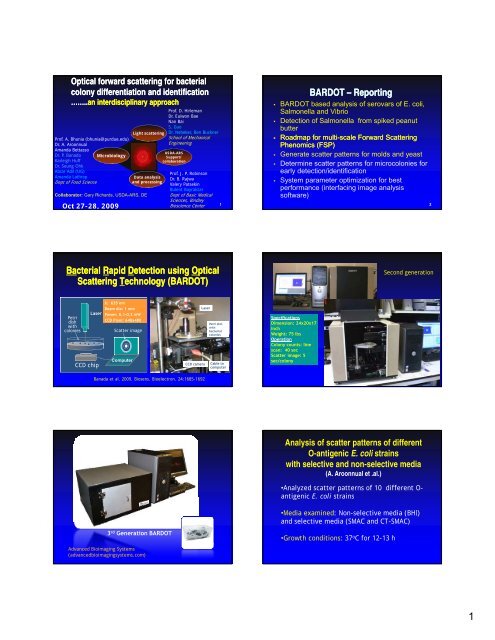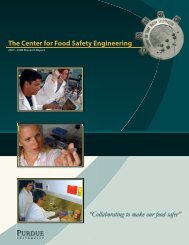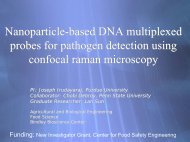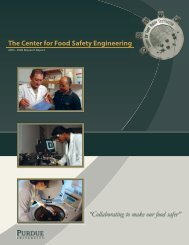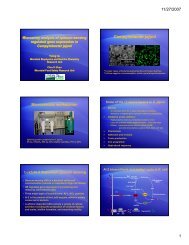BARDOT - Center for Food Safety Engineering - Purdue University
BARDOT - Center for Food Safety Engineering - Purdue University
BARDOT - Center for Food Safety Engineering - Purdue University
- No tags were found...
You also want an ePaper? Increase the reach of your titles
YUMPU automatically turns print PDFs into web optimized ePapers that Google loves.
Optical <strong>for</strong>ward scattering <strong>for</strong> bacterialcolony differentiation and identification……..an interdisciplinary approachLight scatteringProf. A. Bhunia (bhunia@purdue.edu)Dr. A. AroonnualAmanda BettassoDr. P. Banada MicrobiologyKarleigh HuffDr. Seung OhkAbrar Adil (UG)Amanda LathropData analysisDept of <strong>Food</strong> Scienceand processingCollaborator: Gary Richards, USDA-ARS, DEOct 27-28, 2009Prof. D. HirlemanDr. Euiwon BaeNan BaiS. GuoDr. Nebeker, Ben BucknerSchool of Mechanical<strong>Engineering</strong>USDA-ARSSupport/collaborationProf. J. P. RobinsonDr. B. RajwaValery PatsekinBulent BayraktarDept of Basic MedicalSciences, BindleyBioscience <strong>Center</strong>1<strong>BARDOT</strong> – Reporting• <strong>BARDOT</strong> based analysis of serovars of E. coli,Salmonella and Vibrio• Detection of Salmonella from spiked peanutbutter• Roadmap <strong>for</strong> multi-scale Forward ScatteringPhenomics (FSP)• Generate scatter patterns <strong>for</strong> molds and yeast• Determine scatter patterns <strong>for</strong> microcolonies <strong>for</strong>early detection/identification• System parameter optimization <strong>for</strong> bestper<strong>for</strong>mance (interfacing image analysissoftware)2BacterialRapidDetection using OpticalScattering Technology (<strong>BARDOT</strong>)Second generationPetridishwithcoloniesCCD chipλ: 635 nmBeam dia: 1 mmLaser Power: 0.1-0.2 mWCCD Pixel: 640x480Scatter imageComputerCCD cameraLaserPetri dishwithbacterialcoloniesCable tocomputerSpecificationsDimension: 24x20x17inchWeight: 75 lbsOperationColony counts: linescan: 40 secScatter image: 5sec/colonyEnUrgaBanada et al. 2009. Biosens. Bioelectron. 24:1685-16923 rd Generation <strong>BARDOT</strong>Advanced Bioimaging Systems(advancedbioimagingsystems.com)4 th generation!!!Analysis of scatter patterns of differentO-antigenic E. coli strainswith selective and non-selective media(A. Aroonnual et .al.)•Analyzed scatter patterns of 10 different O-antigenic E. colistrains•Media examined: Non-selective media (BHI)and selective media (SMAC and CT-SMAC)•Growth conditions: 37 o C <strong>for</strong> 12-13 h1
Cryo-SEM photographs of coloniesL. mononocytogenes L. innocuaL. monocytogenes L. innocuaO-antigen• Part of lipopolysaccharide (LPS) in gram-negativebacteria (Lipid A, Core polysaccharide, and O-polysaccharide)• O-antigen specific chains determine specificity2015L. monocytogenesL. innocua600500400L. mono L. innocuaBanada et al. 2007. Biosens.Bioelectron. 22:1664Banada et al. 2009. Biosens.Bioelectron. 24:1685mg/ml1050EPSProteinsµg/ml3002001000Pentosesand uronicacidsHexoseshttp://bs.kaist.ac.kr/~mbtlab/Gram_Neg.jpgGram-negative cell wallhttp://www.mbl.edu/marine_org/images/animals/Limulus/blood/lpstyl01.gifLipopolysaccharide of Gram-negative bacteria<strong>BARDOT</strong> images of E. coli colonies on BHIE. coli strain Time (h) Images on BHIO157:H7 DEL933O157:H7 SEA13A531212O127:H6 EPECO142:H6 EPECO25:K98 NM ETEC121212<strong>BARDOT</strong> images of E. coli colonies on BHIE. coli strain Time (h) Images on BHIO5 NMO46:H381212O111:H11 12O91:H21 12O78:H11 ETEC12<strong>BARDOT</strong> images of E. coli colonies on SMACE. coli strain Time (h) Color Images on SMAC<strong>BARDOT</strong> images of E. coli colonies on SMACO157:H7 EDL93312greyE. coli strain Time (h) Color Images on SMACO157:H7 SEA13A5313greyO5 NM13greyO127:H6 EPEC12greyO46:H3813pinkO142:H6 EPEC13greyO111:H1113greyO25:K98 NM ETEC12pinkO91:H2113pinkO78:H11 ETEC13pink2
<strong>BARDOT</strong> images of E. coli colonieson SMAC and CT-SMACE. coli strain Time (h) Media <strong>BARDOT</strong> Images<strong>BARDOT</strong> analysis of Salmonella serovarswith selective and non-selective media(A. Bettasso et .al.)O157:H7 EDL933O127:H6 EPEC12141218SMACCT-SMACSMACCT-SMAC• Salmonella serovars cultured overnight inRappaport Vassiliadis R10broth• Spread plated on BHI (general) and XLD(selective) and Brilliant Green agars• Incubated at 37°C <strong>for</strong> 12h• Screened with <strong>BARDOT</strong>14Salmonella serovar scatter patternson BHIS. Typhimuriumvar copenhagenS. LitchfieldSalmonella serovar scatter patterns on BHIS. AgonaS. CholerasuisS. IndianaS. HeidelbergSalmonellaTyphimurium on BHIS. PoonaS. TyphiBHI, 12 h,37°CS. EnteriditisPT14bBHI/12 h/ 37°CS. SchottmuelleriS. SeftenbergSalmonella on selective media (XLD)Salmonella on selective media (XLD)S. TyphimuriumvarcopenhagenS. LitchfieldS. AgonaS. CholerasuisSalmonellaTyphimurium on XLDS. IndianaS. HeidelbergS. TyphiS. PoonaXLD/12h/37°CS. EnteriditisPT14b12h /XLD/37°CS.SchottmuelleriS. Seftenberg3
Micro-scale : colony dipole model constructorModeling Results from DDSCATModel Parameters:Bacteria No. = 200Bacteria Size = 0.855 µm x 0.315µm x0.315µmColony Size = 13.5 µm x 1.35 µmDipole Spacing = 0.045 µmWavelength = 0.6328 µm (p-polarized planewave with normal incidence)Bacteria Refractive Index = 1.38Extracellular Refractive Index = 1.40FS is favored against BS with1000 times stronger signalWavefront and Scattering Pattern Generatedby Ray Optics Model (I)Wavefront and Scattering Pattern Generatedby Ray Optics Model (II)-2-1.5-1-0.500.511.52Incoming wave(laser)Bacterial colony as aamp/phase modulatorScattered lightAt image planeWavefront emerging from the colonyimprinted with its 3D phase structurein<strong>for</strong>mation-2 -1.5 -1 -0.5 0 0.5 1 1.5 2Intensity field distribution of thepropagating wave calculated byFresnel DiffractionConclusions<strong>BARDOT</strong> show differential scatter signatures <strong>for</strong>different E. coli serovars primarily onnonselective media<strong>BARDOT</strong> show differential scatter signatures <strong>for</strong>different Salmonella serovars primarily onselective mediaSalmonella was successfully detected from spikedpeanut butter samples with or withoutenrichment from samples stored <strong>for</strong> 0, 7, 14, 21and 28 days at RT.Vibrio cholerae, V. parahemolyticus, V. vulnificuscan be detected from a mixture of other Vibrio35The new version of the <strong>BARDOT</strong> system• Developed at <strong>Purdue</strong> <strong>University</strong> and fundedby USDA• Commercialized by Advanced BioimagingSystems• Fully customizable <strong>for</strong> anyworkflow/requirements• Deployed at USDA July, 2009White lightimagerRed-laserlight sourceSample interogation areaForwardscatterdetector6


